Finding wonderful abstractions on this day at Willow Court with my new lens filled me with joy. Yes, rust and decay antique trucks inspired me.
Colours, forms/shapes lines, negative and positive spaces caught my eyes that just had to be captured.
Will have to return to this amazing visual place, as I only scaped the surface and used two camera lenses the, Fujinon Aspherical 30mm f2 and Fujinon 50mm f2 on a Fujifilm X-T4 camera.
Should you ever wish to see these vintage trucks, cars, buses… see them all and more at the Willow Court Antique Centre.
“I have always looked upon decay as being just as wonderful and rich an expression of life as growth”. - Henry Miller
“In a decaying society, art, if it is truthful, must also reflect decay. And unless it wants to break faith with its social function, art must show the world as changeable. And help to change it.” - Ernst Fischer
Born in Austria, Ernst Fischer (1899–1972) studied philosophy before working as a newspaper editor, radio commentator, and writer; in the years after World War II he became a leading cultural commentator. His books include Art Against Ideology and The Necessity of Art. "Art is necessary in order that man should be able to recognize and change the world. But art is also necessary by virtue of the magic inherent in it." - Ernst Fischer.
Art cuts across every spectrum of life; sociability, spirituality, work, health, it can be perceived as a product of skill and visual representation of time past, the present and the future. Our historical/ancestral backgrounds are embedded in art as it gives us an idea of our roots and clarity of our culture. The necessity of art is beyond ordinary. Art is reflective. Art is bold. Art is necessary. Prof. Frank Ugiomoh





















































